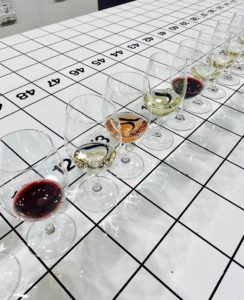I have spent a lot of time over the years investigating the many different aspects of the wine industry, but up until now, I  really had no idea of the level of effort and rigour that goes into judging at a wine show. After stewarding for a couple of days at the Royal Adelaide Wine Show (RAWS), I gained a little insight and a lot of appreciation for the hard work of not only the judges, but for all of the back of house staff, stewards and volunteers who make the show possible.
really had no idea of the level of effort and rigour that goes into judging at a wine show. After stewarding for a couple of days at the Royal Adelaide Wine Show (RAWS), I gained a little insight and a lot of appreciation for the hard work of not only the judges, but for all of the back of house staff, stewards and volunteers who make the show possible.
Over the course of the four-day judging period, six tasting panels made up of two Associate Judges, two Judges and a Panel Chair tasted approximately 2,400 wines. Just stop and think about that for a minute… that’s an exhausting amount of wine, and an even more exhausting number of glasses to polish!
The tastings are of course blind, and kept that way by placing each bottle in a paper bag where it is labelled with the relevant class and exhibit number. Back of House Manager and all round legend, Bryan Jones and his staff spend days receiving, sorting, bagging and labelling wines so that they are all anonymous and ready for judging. It is a big job, but it is an important one. Wines are kept in a separate room, or ‘Bottle Shop’ and this space is out of bounds for judges.
Judging takes place in the Ridley Pavilion at the Adelaide Showgrounds. The pavilion is set up with six judging panels, labelled A through to F. Each panel has 5 white tables that have a strip of numbers marked up in the middle.
It is a steward’s job to place clean glassware on each table for each class of wine that is judged. When judges are ready for a class of wine to be poured, stewards collect the wine from the Bottle Shop, and then very carefully pour the numbered wines into the corresponding glasses on each table.
Each panel will usually taste a different class of wine, for example Panel ‘A’ might taste Chardonnays, while Panel ‘B’ might taste through a class of Shiraz’s. The number of wines to taste in each class depends on how many wines are entered into that class.
Judges will then taste the wines, looking at colour, aroma and flavour characteristics. The wine is given a score out of 20 points, and the panel meets to discuss why certain scores were given to certain wines. Wines with high scores may be ‘called back’ to be re-tasted. This allows the panel to ensure the particular wine is deserving of a medal.
Once judges have finished tasting, the stewards clear and replace glassware ready for the next class of wines to be poured.
Until recently, the RAWS used an onerous and labour intensive handwritten, paper based system for recording scores and information. The introduction of new competition software this year completely streamlines the judging process, moving it to an electronic system. The new environmentally friendly system results in better quality control, and allows for instant results, as scores no longer need to be added up manually.
The system is particularly user friendly and judges receive a report at the end of judging each wine class, allowing them to compare their notes and scores with other judges. This also allows judges to see whether they are on track in terms of judging wines correctly, and can also reveal areas in their tasting skills where they may need to improve.
For example an Associate Judge, who is still learning, might be very good at accurately scoring in a Shiraz class, when compared to other judges, but their scores for a chardonnay might be less accurate. The technology allows judges to see their tasting strengths and weaknesses, which is great for judges who are honing in on their tasting skills.
On my second day of stewarding, I was ushered deep into the Bottle Shop to assist with decanting and pouring wines for the auspiciously named “Gramp Hardy Hill-Smith Prize for the Outstanding Wine of Provenance” – the RAWS’s most prestigious prize.
This prize allows established wineries that have kept a proportion of their older vintages, to enter three wines (either a red or a white) for consideration across several years. For example, a winery might submit three different vintages of Cabernet Sauvignon, say a 2016, a 2009 and a 2004, for what is known as a ‘vertical tasting.’
For a winery to be awarded the Prize, they must be able to showcase quality, longevity, identity, personality and individuality across the three vintages of their chosen variety. It was an absolute honour to open and decant these wines for judging.
Over my two days of stewarding, the back of house team cracked and poured more than half of the wines entered in the show, polished approximately 10,000 glasses and racked up quite a few steps. My hands have never been so sore from polishing glasses, but that would not stop me from helping out at next years show.
The 2019 Royal Adelaide Wine Show results can be viewed here
Written by Mariette Morris, 2019 WCA Wine Media Cadet
